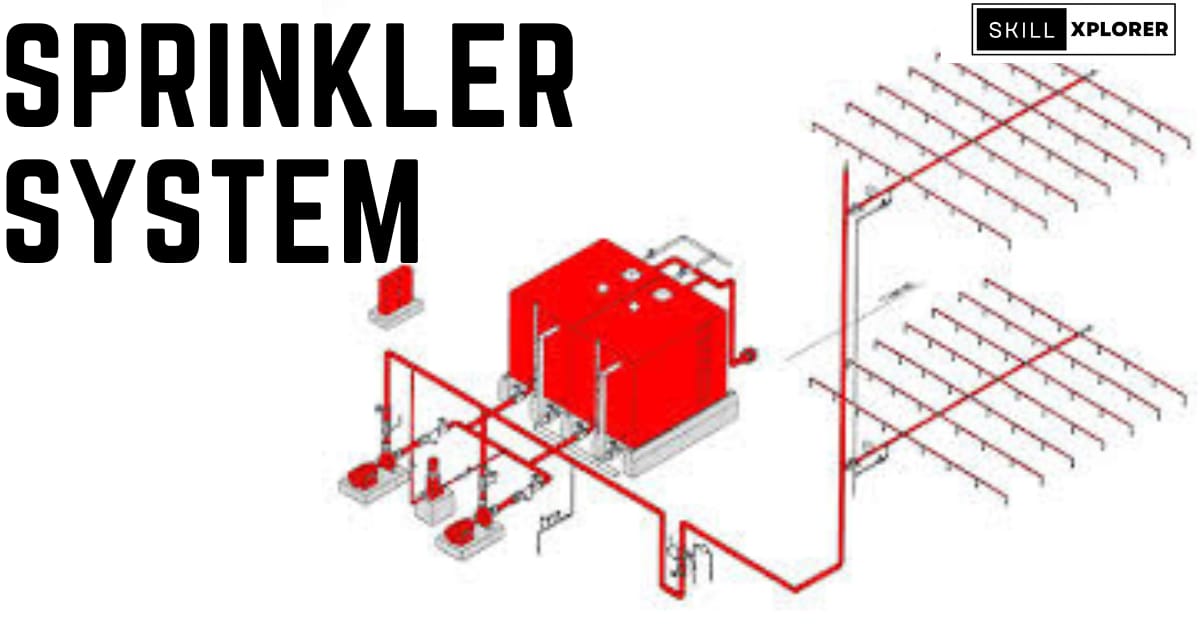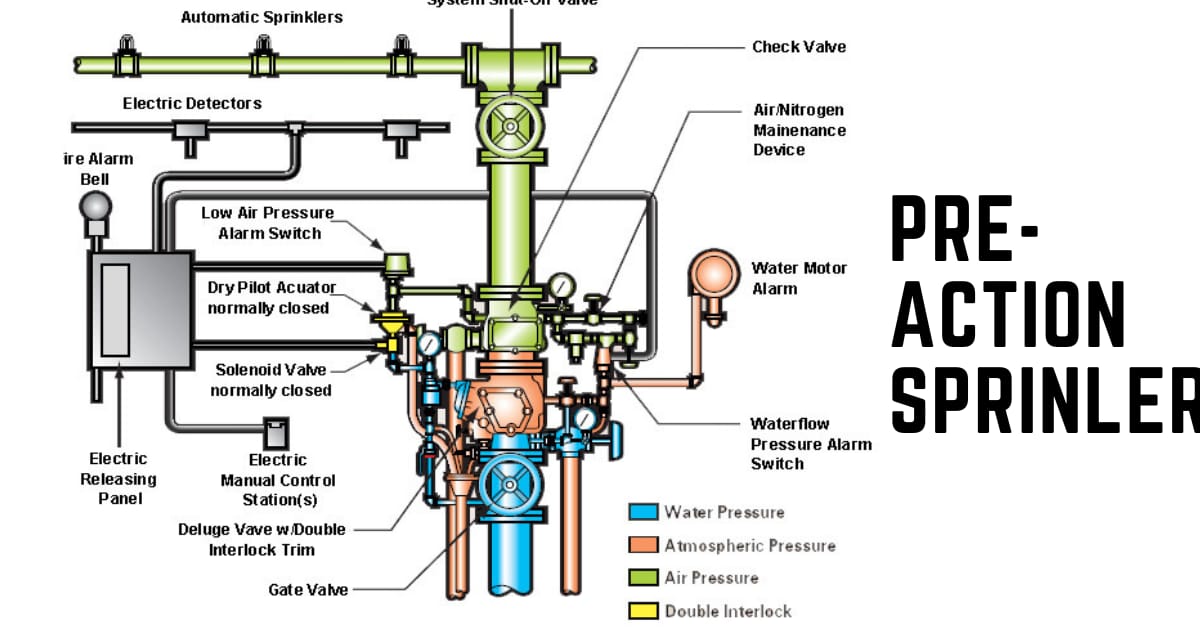Fire sprinkler system
A fire sprinkler systems is a network of pipes, water supply, and sprinkler heads designed to automatically detect and extinguish or control fires in buildings. It is an active fire protection measure commonly used in residential, commercial, and industrial settings.

Image source : fireknock.com
There are four major classification of fire sprinkler systems.
- Pre action
- Dry pipe
- wet pipe
- Deluge
1. Pre- action sprinkler system
Pre Sprinkler system are filled with water and air is allowed to pass through when the smoke alarm or alarm goes off. It is commonly used in areas where water damage needs to be minimized, such as computer rooms, data centers, museums, and other locations with sensitive equipment or valuable assets.
- Activation: The system requires two separate events for activation. Firstly, a fire detection system, such as smoke detectors or heat detectors, detects the presence of a fire. Once a fire is detected, the pre-action valve remains closed, preventing water from entering the sprinkler piping.
- Alert: Upon fire detection, an alarm is triggered to alert occupants and notify the fire department.

Image Source:= LinkedIn www.skillxplore.com
2. Wet Sprinkler system
It is designed to automatically detect and extinguish fires by distributing water through a network of pipes and sprinkler heads. wet sprinkler system constantly have water in them. This allow to quick reaction to fire and it is most common type of sprinkler installed in the building. This type of sprinkler low low cost and low maintenance.

Image Courtesy: extremefire.com.au
3. Dry Sprinkler system
Dry sprinkler system are similar to pre action sprinkler system as the are pressurized air in the pipe. This cause of minute delay in water discharge but is ideal for buildings with low temperature so the pipe do not freeze. It is commonly used in areas where freezing temperatures can occur, such as unheated or poorly insulated buildings.
4. Deluge Sprinkler system
Deluge system use where high hazard location such as power plant, refineries, chemical plant. A deluge system is a type of fire suppression system that is designed to quickly discharge a large amount of water over a wide area in response to a fire. Unlike sprinkler systems, where individual sprinkler heads activate based on heat detection, a deluge system operates with all nozzles open simultaneously when the system is triggered. Deluge systems are often used in high-hazard areas where fires can spread rapidly, such as chemical storage facilities or power plants. Fire detection devices, such as smoke or heat detectors, are strategically placed throughout the protected area to sense the presence of a fire.
Types of Sprinkler System according to Orientations
- Pendent sprinkler
- Upright sprinkler
- Sidewall sprinkler
- Concealed sprinkler

1. Pendent Sprinkler
Pendent Sprinklers: Pendent sprinklers are the most widely used type of fire sprinklers. They hang down from the ceiling and feature a deflector at the bottom. When its activated, water is dispersed in a circular pattern down the sprinkler head, its covering a wide area of building.
2. Upright Sprinkler
Upright Sprinklers: Upright sprinklers are mounted in an upright position on the ceiling. It’s always upright position, It has a deflector at the top, and when it’s activated, water is dispersed in a vertical pattern, reaching the surrounding area in a dome-shaped pattern.
3. Side Wall Sprinkler
Sidewall Sprinklers: Sidewall sprinklers are mounted on the side walls of a room instead of the ceilings. They are commonly used in areas where ceiling installation is not possible or not preferred for appearance. Sidewall sprinklers project water horizontally across the protected area.
4. Concealed Sprinkler
Concealed Sprinklers: Concealed sprinklers are designed to blend in with the ceiling and remain hidden from view. They are recessed into the ceiling with only the decorative cover plate visible. Cover plate is matching with ceiling. When it is activate, the cover plate drops off, and the sprinkler head releases water across designated area.
FAQs
1. How does a fire sprinkler system work?
Fire sprinkler frameworks work on the standard of intensity recognition. Every sprinkler head is furnished with an intensity delicate component (bulb), generally a glass bulb or a metal fusible connection, it is intended to crack or soften at a particular temperature, every sprinkler has explicit temperature to dissolve. At the point when the surrounding temperature approaches or surpasses the edge, the intensity delicate component actuates, permitting water to course through the sprinkler head and onto the fire.
2. Are all sprinkler heads activated simultaneously during a fire?
No, fire sprinkler systems are designed to activate individually. Each sprinkler head is independent and operates based on the heat conditions within its vicinity. Only the sprinkler heads directly affected by the fire will activate, minimizing water damage in unaffected areas.
3. What are the different types of fire sprinkler systems?
There are several types of fire sprinkler systems, including:
-
Pre- action sprinkler system
Pre Sprinkler system are filled with water and air is allowed to pass through when the smoke alarm or alarm goes off. It is commonly used in areas where water damage needs to be minimized, such as computer rooms, data centers, museums, and other locations with sensitive equipment or valuable assets.
-
Wet Sprinkler system
It is designed to automatically detect and extinguish fires by distributing water through a network of pipes and sprinkler heads. wet sprinkler system constantly have water in them. This allow to quick reaction to fire and it is most common type of sprinkler installed in the building. This type of sprinkler low low cost and low maintenance.
-
Dry Sprinkler system
Dry sprinkler system are similar to pre action sprinkler system as the are pressurized air in the pipe. This cause of minute delay in water discharge but is ideal for buildings with low temperature so the pipe do not freeze. It is commonly used in areas where freezing temperatures can occur, such as unheated or poorly insulated buildings.
-
Deluge Sprinkler system
Deluge system use where high hazard location such as power plant, refineries, chemical plant. A deluge system is a type of fire suppression system that is designed to quickly discharge a large amount of water over a wide area in response to a fire. Unlike sprinkler systems, where individual sprinkler heads activate based on heat detection, a deluge system operates with all nozzles open simultaneously when the system is triggered.
4. Do fire sprinkler systems cause a lot of water damage?
While fire sprinkler systems do discharge water to control fires, the amount of water used is typically significantly less than what would be used by firefighting hoses. Furthermore, because sprinklers are designed to activate individually, only the sprinkler heads in close proximity to the fire will discharge water, minimizing water damage in other areas of the building.
5.Are fire sprinkler systems required by law?
Fire sprinkler system requirements vary by jurisdiction and building type. In many countries, building codes and regulations mandate the installation of fire sprinkler systems in commercial buildings, high-rise residential buildings, industrial facilities, and other structures. It’s important to consult local fire codes and authorities to determine the specific requirements for a particular building.
6. What is NFPA standard code for sprinkler system?
NFPA: 13 It is standard for the installation of sprinkler systems published by NFPA in the united state.
7. How do sprinkler systems work?
Sprinkler systems have these tiny glass bulbs or metal links in each sprinkler head. These parts are super sensitive to heat. When there’s a fire and the temperature nearby gets too hot, the glass breaks or the metal melts, triggering the sprinkler head to start spraying water. It’s like a firefighter on duty 24/7.
8. Do all the sprinklers go off at once?
Nope, that’s a myth you often see in movies. In reality, each sprinkler head has its own mind. Only the sprinkler(s) closest to the fire will activate, while the others stay cool and calm. It means less water is used, and damage is contained to the fire area.
9. How often do sprinkler systems need maintenance?
Sprinkler systems need regular check-ups to make sure they’re ready to do their job when needed. Professional inspections are typically recommended once a year. More detailed tests and maintenance should be done every few years. Keeping them in top shape is crucial for their effectiveness.
10. Are sprinkler systems effective in stopping fires?
Absolutely! Sprinkler systems are superheroes for a reason. Statistics show that they work over 90% of the time in fires where they’re activated. In about 96% of those cases, they actually control the fire, preventing it from spreading and causing more damage. They’re a reliable line of defense.
Thank you
Read More:
Piping Flange, Flange Types, Flange Standard and Flange application


Pingback: Confined Space Safety/Confined space hazards and precautions